How We Chose the Perfect Planning Poker Tool
Planning poker® is a great technique for scrum teams. It is a team-based estimating approach to work out the efforts involved for achieving business goals. Even serious developers like gamification!
Our company is a part of Wisebits Group and develops an online entertainment streaming service. The organization consists of several software dev teams that develop different parts of our product. We use planning poker with these teams and as there are a lot of products to choose from, we spent some time testing different ones to find the perfect match.
I decided to share our feedback about the planning poker tools we tried, so it would save you time if you’re looking for an effective tool for your team.
What we needed
At first all our employees were working from the same office, so usually we arranged our estimation sessions in the meeting room and used ScrumTime app, which is just a set of planning poker cards that you have on your mobile device.
Later we also ordered the Planning Poker cards deck on Amazon.
As the team grew, we noticed that even in the same room it was not convenient to use real cards because people couldn’t see them easily in a large group. So we decided to try some online tools that would display the results on the screen for the whole team. Later, when pandemic began, we managed to adapt very quickly as we had already switched to online tools.
During our tools research I focused on the points that were considered important for us:
- The planning poker app should be convenient to be used both on desktop and mobile (as sometimes we meet in the same room without our laptops but with mobile devices only).
- There should be no ability to update your vote after the cards are revealed (some apps allow that for some reason).
- There should be the option for the moderator to reveal the cards even if everyone has not yet voted (as a moderator I do not vote; also in case any member of the team has technical problems and has to reconnect, for example, the team should have the possibility to keep the discussion moving).
- The planning poker tool should keep the history from the previous sessions.
What we tried
We tried 6 planning poker tools. Let’s look at the pros and cons of each.
1. Pointing Poker
Pointing Poker was the first and the simplest tool I tried.
Pros
- It’s free although you can offer a donation.
- It does not require registration; you can just create a new session or join an existing one and go.
- You can customize your scale.
- You can choose in the settings for who can reveal or reset cards.
This last point was a good thing for us as usually we prefer only moderators to do this, so other team members don’t do it by mistake.
Cons
- Participants can change their votes even after the cards are revealed. To be honest this fact made me continue looking for something else as it contradicts the main idea of scrum poker which is that everyone votes independently and does not influence the other participants’ sizing.
- You can’t export the list of stories for the estimation. You can only copy the Story description before each voting round – it’s not convenient and takes additional time during the session.
- It’s impossible to keep the estimations history to come back to it later if needed (in our case it’s really useful as we move all the estimations to JIRA and it helps to check the votes sometimes).
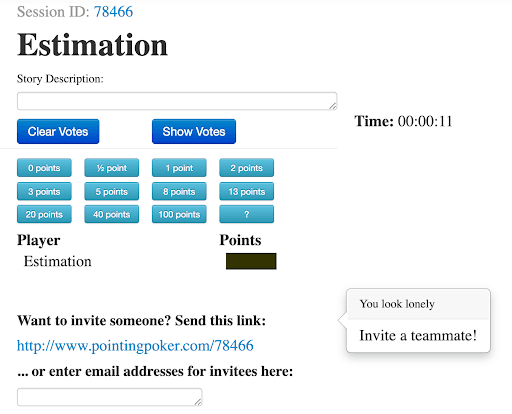
2. Scrumpoker Online
Scrumpoker Online was the next tool I tried.
Pros
- It’s free.
- There are sets of scales in case you do not use Fibonacci but choose to use T-Shirt scales or anything else.
Cons
- Only session creators can see the whole picture. Players can only see their vote even after revealing the cards. The website recommends that the scrum master view is displayed on a big screen, like a TV or projector, and everyone else joins by smartphone. That was not convenient for us at all.
- The session creator can’t vote: for us it was OK but there are some teams for whom this will not be convenient.
- No history, no possibility to copy-paste the list of Stories in advance, in contrasts to Pointing Poker.
They also provide JIRA/GitLab/GitHub integration but we never used it, as we did not want to open access to our JIRA space for any external tools we’re not 100% sure of.


There are 2 more free tools that I tested by myself but we never used with any teams.
3. Scrumpoker-online.org
Scrumpoker-online.org allows changing votes after the cards are revealed, it does not give ability to paste or import stories list, and there is no history kept. That meant it was not suitable for us and we passed it over.
Scrumpoker-online.org allows changing votes after the cards are revealed, it does not give ability to paste or import stories list, and there is no history kept. That meant it was not suitable for us and we passed it over.
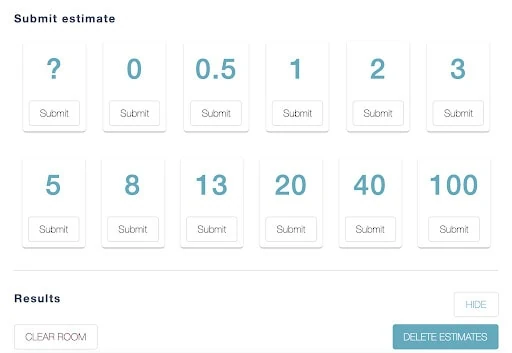
4. Pokrex
Pokrex provides a simple UI (it reminded me of Pointing Poker), contains different scales, but allows changing votes after the cards are revealed.
Moreover, I noticed one more inconvenient thing for us: though you can upload stories list to the tool you can’t change their order during estimations. You either estimate the story or skip it (then it disappears from the list). For us it’s normal to postpone the story and come back to it during the meeting.
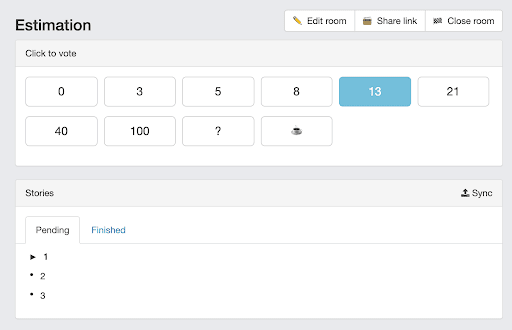
5. Planning Poker
After testing all these free tools we decided to compare them with paid versions and started a free trial of Planning Poker. They offer different plans based on the number of members (it’s free for up to 5 people – that would not be enough for us but could be fine for other small teams).
We had a 14-day free trial for up to 10 players per game to decide if it suited our needs.
Here is the list of settings you can choose before each session with your team:
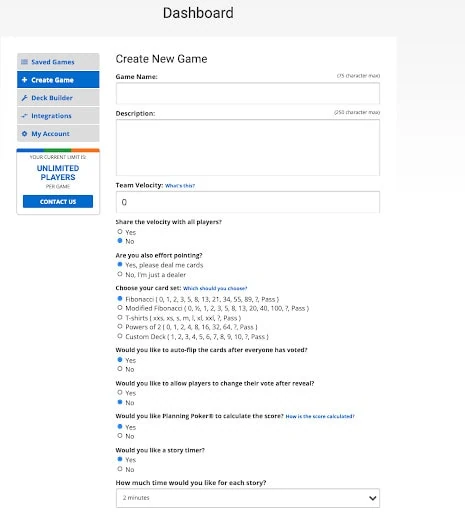
Pros
- Many custom settings that you can choose once and save as default.
- JIRA integration support. It’s also possible to import the file with a Stories list or just copy and paste them manually as we usually do.
- It keeps all the sessions’ history, so you can come back to the previous results at any time or export them as .csv.
- Even during the game at any time moderator can switch from “Spectator” to “Active” mode or back and join voting or skip it.
Cons
- It’s the only paid tool among the all ones I tested, and from my point of view it does not contain any killer features in comparison to others.
- Looks a bit overloaded with the features and multiple settings. It looks like they tried to implement as many features as possible and contains some settings we would not use at all, like a time limit for each story or the option to show the velocity to the players.
What we chose
After reviewing all the products above, we finally found one that we’ve stuck with.
6. Chpokify
The latest online tool we used with the teams is Chpokify. It fits all our requirements and provides some unique functionality that we did not find in other tools.
From the start it was easy to use. It has a simple and transparent UI: usually when I prepare for the estimation sessions, it takes me just 2 minutes to create a new session, import all the Stories by copy-pasting, and assign the necessary teams to the session.
Plus, there are no difficulties while using this tool on mobile devices, we use it both on iOS and Android platforms.
Setting up Chpokify was easy as it allowed us to create several teams for the space. Assigning members to the space makes our life much easier: most of our dev teams are cross-functional and contain frontend devs, backend devs and QA engineers, so with Front/Back/QA sub-teams we can estimate simultaneously and see estimations for each sub-team.
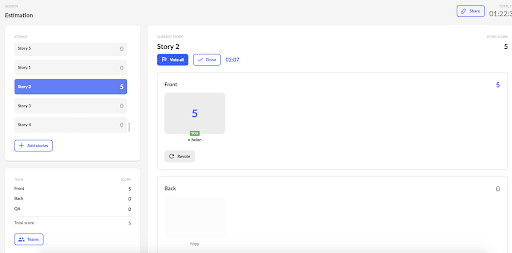
Pros
- Ability to create different spaces for different teams and set access preferences for different accounts (you can keep history for several sub-projects in separate spaces and you can switch between them easily).
- It supports smart links, so you can switch easily to your task tracker to see more details about the Story.
- As a moderator you can start voting by “Vote all” button for all the teams, in case there are some disagreements in one of the sub-teams, it’s easy to activate revoting for this team only.
- There is a timer for each Story, so you can monitor and moderate how long the discussion lasts, also time spent for each session is available in the stats afterwards.
- Clear view both for the moderator and players – it’s easy to manage the session, reassign members between the teams during the session, ability to see votes for all the teams from players’ side.
- Ability to see total score for each of the team at the moment: you can compare it with the team velocity and see when you have enough Stories from the top of Backlog for the next Sprint.
There’s a basic account that provides a lot of this functionality for free, and even the paid plans are very reasonably priced.
Cons
We didn’t find any true disadvantages, but here are a few things that might be inconvenient for some teams.
- At the time we were testing, Chpokify didn’t have a variety of decks to choose from. That wasn’t an issue for us as we only use the Fibonacci scale with all our teams. However, now they have the option to use 7 different scales or to create a custom deck.
- Registration is required for the first time you use it.
For that last point, I know that some teams prefer joining without any additional steps such as signing up via email, but in our case accounts creation is good for security reasons – you can distribute teams or /projects between the Spaces, so each team will have access to its Space only. And after being signed up once they can join every session easily by the shared link.
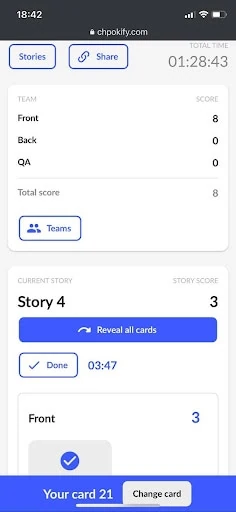
Since we have started using Chpokify we stopped testing other ones, as now we’re happy with what it provides.
Moreover, Chpokify also has support for retrospectives and basic Kanban boards. These features are still in beta release but it will be convenient to use the same tool for all scrum rituals.
What we also use
For the cases when we need to estimate a few more stories between our planning sessions, we use Poker Planner for Slack, as Slack is our main tool for communication in the company. It’s super easy to use – you can choose the default or create a new card set, tag players and decide who can reveal the cards.
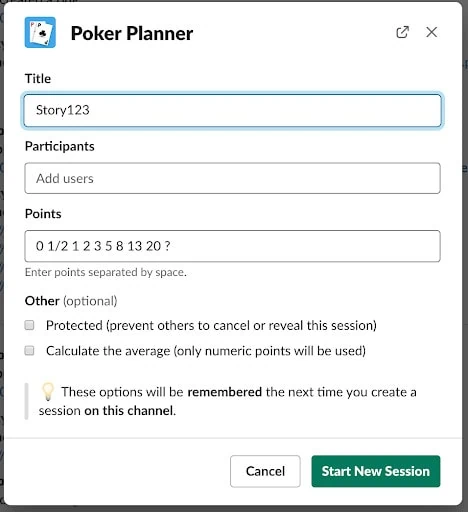
We also heard about the plugin Planning Poker for JIRA but we have not tried it yet, as for now we have everything we need. Maybe later we will experiment with it as well and share some feedback.
How to decide on a planning poker tool for your team
Planning poker is a rather popular technique that is used by many teams all over the world and not only by IT companies. I have seen successful Marketing, Design and Analyst teams using this technique
Even though the principles of planning poker are simple, and the approach is the same for everyone, each team will has their own culture, approaches and habits, so there are tools with different features on the market nowadays to meet those diverse needs.
If you do not have any ‘special’ requirements and your only need is to have the cards set, voting and go further, then choose the simplest free tool such as Pointing Poker or similar.
If you would like to keep previous sessions’ history, integration with any other systems or you have other needs, there is no better way than check out some tools I mentioned above with your team or just by yourself. As our experience shows, it’s enough to have just one estimation round to find out if you have found your perfect match.
Planning Poker® is a registered trademark of Mountain Goat Software, LLC.
This article was made possible with the support of Chpokify.
